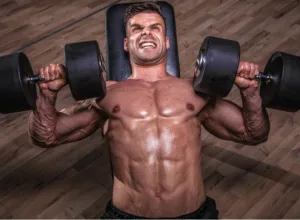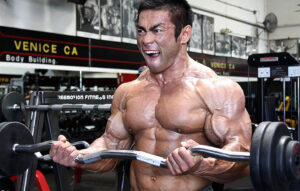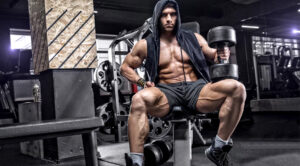Hitting the gym with the sole purpose of sculpting some serious muscle? You’re not alone. Building muscle requires dedication, consistency, and most importantly, proper training techniques.
One crucial aspect that often gets overlooked is the warm-up. A well-designed warm-up primes your body for optimal performance and maximizes the muscle-building effect of your workout. Let’s dive into the science behind a good warm-up and explore effective strategies to get the most out of your time under the iron.
Why is Warming Up Important for Muscle Building?
Imagine your body as a finely tuned machine. Before pushing it to its limits, wouldn’t you want to ensure all the parts are lubricated, warmed up, and ready for intense activity? That’s precisely what a proper warm-up does for your muscles.
Here’s a breakdown of the key benefits:
- Increased Blood Flow: Warm-up exercises elevate your heart rate and blood flow, delivering more oxygen and nutrients to your muscles. This prepares them for the demands of lifting heavier weights, ultimately leading to better performance and potentially greater muscle growth.
- Enhanced Muscle Temperature: Cold muscles are stiff and prone to injury. A good warm-up elevates your muscle temperature, improving their flexibility and range of motion. This allows for a deeper, more controlled workout, maximizing the targeted muscle fibers engaged in each exercise.
- Improved Nervous System Activation: The warm-up acts as a bridge between your mind and muscles. It primes your nervous system, sending signals more efficiently to your muscles, leading to better coordination, power output, and ultimately, increased strength gains.
- Reduced Risk of Injury: Stiff muscles are more susceptible to tears and strains. A proper warm-up increases flexibility and prepares your joints for heavier loads, significantly reducing the risk of injury, allowing you to train harder and more consistently.
 The Warm-Up Formula: A Multi-Pronged Approach
The Warm-Up Formula: A Multi-Pronged Approach
An effective warm-up should incorporate elements that address both your cardiovascular system and your targeted muscle groups. Here’s a breakdown of the key steps:
1. Light Cardio (5-10 Minutes):
- Get your heart rate elevated and blood flowing with light cardio like brisk walking, jogging on the treadmill, or jumping jacks. Aim for a moderate intensity, where you can still carry on a conversation.
2. Dynamic Stretches (5-10 Minutes):
- These stretches involve controlled movements that mimic the actions of your upcoming weightlifting exercises. Examples include arm circles, leg swings, lunges with torso twists, and high knees. Dynamic stretches gently increase your heart rate further while improving your range of motion and preparing your muscles for specific movements.
3. Muscle Activation Drills (3-5 Minutes):
- Activate the muscle groups you plan to target during your workout with bodyweight exercises or light weights. This could include bodyweight squats, lunges, glute bridges, push-ups, or shoulder rotations with light dumbbells.
4. Focus on Mobility Exercises (Optional):
- If you have any specific tight areas or limitations, address them with targeted mobility exercises using a foam roller or lacrosse ball.
Check Out Our List Of The Best Supplements For Building Muscle, Shredding Muscle, Recovery, And Great Health, and Wellness Products! Purchase ifbnewsfeed.org‘s apparels Here: ifbnewsfeed.org
 Should I warm up before lifting weights?
Should I warm up before lifting weights?
Is warming up for wimps? No! Drop the image of the spandex-clad, sweatband-wearing jogger trying to lift their big toe up to their nose, because warming up properly before hitting the weights will help you maximize the muscle-building effect of any workout.
Why warm-up? In short, warming up before engaging in strenuous lifting will prepare the target muscles, joints, and the CNS (central nervous system), help focus the mind on the task ahead and reduce fatigue.
We’re going to look at non-aerobic warm-ups – specifically, warm-up sets, using weights – no foam rolling, stretching, or running on the spot involved.
For example, if a person were about to squat 175 pounds, regardless of if their sets were “straight” (in which the weight stays the same for every set) or a “reverse pyramid” (in which the weight becomes lighter with every set), they would do well to warm up for that exercise progressively, beginning with lighter weights and working their way up nearly to the target weight – because either set type begins with the heaviest weight which will be lifted.
Going from no exertion to 175-pound squats without preparation is, put simply, a bad idea.
In a nutshell, adequately preparing the muscles, joints, CNS, and mind means performing a series of increasingly heavy sets which bring you quite close to the working weight you intend to lift during the actual workout – while progressively decreasing reps to prevent excessive fatigue.
That last line is important – a warm-up should use fewer reps as the weight increases to avoid draining your energy before engaging in the main workout. Failing to grasp this simple but critical concept means less power to commit to the task at hand, more fatigue, and frustration.
 The Proper Sequence
The Proper Sequence
Now you know why warming up properly matters. So, how do you do it? For the majority of lifters, the following sequence works very well:
1. 1 extremely light set of 12 to 15 repetitions, using very light dumbbells, an empty bar, or a machine with a very low weight.
2. 10 repetitions of 55 to 60 percent of the working weight to be used during the actual sets of the exercise you will be doing.
3. 5 repetitions of 70 to 75 percent of the working weight to be used during the actual sets of the exercise you will be doing.
4. 3 repetitions of 80 to 85 percent of the working weight to be used during the actual sets of the exercise you will be doing.
5. 1 repetition of 90 to 95 percent of the working weight to be used during the actual sets of the exercise you will be doing.
Follow up with an appropriate period of rest before engaging in actual working sets using the working weight. After every warm-up set, except the final 1 repetition, rest between 45 and 60 seconds. After the last repetition, rest as long as you normally would for that amount of weight.
Under most circumstances, this is an ideal warm-up sequence. Your body will be prepared. The working sets will feel less strenuous, since warming up properly gives the central nervous system time to acclimatize itself to nearly the maximum weight you will be lifting, and you will already have a “feel” for the movements involved – far preferable to develop it with lighter weights than struggle to lift hundreds of pounds with good form straight away.

However, there are a few exceptions:
- The more weight being lifted, the more you have to warm up. Conversely, the less weight being lifted, the less you have to warm up.
- Beginners needn’t work their way as high up the warm-up sequence (to 95 percent of the working weight) as more experienced lifters.
- Warm-up sets should be tailored to intensity. For example, a session of 4 sets of squats for 6 repetitions entails a heavier working weight than 3 sets of 12 repetitions. Adjust accordingly.
- Complex exercises may warrant a more complete warm-up set then a simple exercise (such as dumbbell curls).
The warm-up sequence we’ve suggested is not necessary before every exercise. As a general rule, it only needs to be done when first exercising a specific muscle group.
For example, a warm-up set for one type of chest exercise doesn’t need repeating for every following type of chest exercise, since the target muscles have already been prepared. Small muscle groups – particularly, the biceps and triceps – seldom, if ever, require serious preparation (Small muscles: Just a few lights sets to warm the muscle and joint, get the blood flowing and get a feel for the working set is enough); any warm-up sets done which target the large muscle groups will, consequently, get the arms limber and ready for action.
Remember:
- Tailor your warm-up to your workout routine. If you’re focusing on lower body exercises, emphasize dynamic stretches and activation drills for your legs and core.
- Gradually increase the intensity of your warm-up as you progress through the stages.
- Listen to your body. Stop if you experience any pain and adjust the intensity or exercises accordingly.
 Beyond the Warm-Up: Optimizing Your Muscle-Building Workouts
Beyond the Warm-Up: Optimizing Your Muscle-Building Workouts
A proper warm-up sets the stage, but maximizing muscle growth requires a holistic approach. Here are some additional tips to consider:
- Progressive Overload: Continually challenge your muscles by gradually increasing the weight, sets, or reps over time. This forces your muscles to adapt and grow stronger.
- Focus on Compound Lifts: Exercises like squats, deadlifts, bench presses, and rows incorporate multiple muscle groups, leading to greater overall muscle growth and strength gains.
- Maintain Proper Form: Don’t sacrifice form for heavier weights. Using proper form ensures you target the intended muscles and minimizes the risk of injury.
- Rest and Recovery: Give your muscles adequate time to recover between workouts. Aim for 48-72 hours of rest for the same muscle group.
- Prioritize Nutrition: Fuel your body with a balanced diet rich in protein to provide the building blocks for muscle growth.
More About The Ultimate Guide to Warming Up for Muscle Building Contents
- The Best “15-Minute Warm-Ups” To Speed Up Muscle Growth, Physical & Mental Strength, And Fast Recovery
- Build Up Insane And Shredded Legs (Quads & Hamstrings) With These “5 Best Dumbbell Exercises”
- The “Best Sleep Aid Supplement” for Bodybuilding: A Complete Guide to “Unlimited Sleeping”

- Get $200 With Your 1st Order Because Your Health Matters
- Best Supplements For Muscle Building, Strength & Champion Performance
- Best Supplements For Intense Energy, Performance & Endurance
For More News And Daily Updates, Follow IFBNewsfeed.Org on Facebook, Twitter, and Instagram. Comment, Like, And Share With Everyone Who May Need To Be Updated With The Most Recent Fitness/Bodybuilding/Powerlifting And CrossFit News.







